

|
| UNITED STATES OF AMERICA | |
| CONNECTICUT | |
| New Haven County |
 New Haven is located on Connecticut's south coast where the Quinnipiac and other rivers enter Long Island Sound.
Originally the area was inhabited by a small tribe of native Indians, the Quinnipiack.
New Haven is located on Connecticut's south coast where the Quinnipiac and other rivers enter Long Island Sound.
Originally the area was inhabited by a small tribe of native Indians, the Quinnipiack.
In 1638 a company of about 500 puritans led by the Reverend John Davenport and the merchant Theophilus Eaton arrived from England.
The Quinnipiacks sold their land to the Puritans and the latter in return promised to protect the natives from rivaling tribes.
The original settlement of the Puritans had been called Quinnipiac but already in 1640 was renamed Newhaven.
New Haven's founders wanted to create a Christian utopia and at the same time had hoped to establish a commercial centre
controling Long Island Sound and the further coastland. However, over the years New Haven lost most of its commercial importance
to New Amsterdam (today New York) and Boston. When English forces
seized New Amsterdam in 1664 New Haven reluctantly agreed to be united with Connecticut. In 1701 it even became the co-capital of
Connecticut along with Hartford, and retained his status until 1875. In 1784, New Haven was incorporated as a city
and Roger Sherman, one of the signers of the Declaration of Independence, was elected first mayor.
In the late 18th and early 19th centuries, New Haven was a thriving port.
New Haven was raided by British forces in the American Revolution, and the port was blockaded during the War of 1812.
However, unlike Norwalk and Fairfield the British did not burn the city and casualties were relatively few.
New Haven's population surged during the 19th century and by 1900 it had grown to about 108,000 with about 29% of them being immigrants.
After the world wars a considerable part of the population left the old city centre to settle in new suburbs. From 1954 more than $300 million
were spent to revitalize the old city and efforts are continuinguntil today.
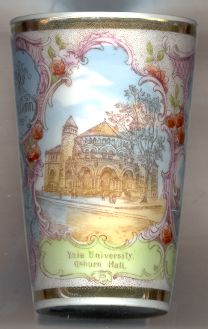
In 1701, a small Puritan college known as the Collegiate School was founded in Killingworth. In 1716 it moved to New Haven, and, after receiving a large benefaction from the merchant Elihu Yale, was renamed Yale College in 1718. In 1887 Yale College became Yale University.
 Osborn Hall [right], was constructed in 1888 and was named for the benefactor Miriam Osborn.
The building was demolished in 1926.
Osborn Hall [right], was constructed in 1888 and was named for the benefactor Miriam Osborn.
The building was demolished in 1926.
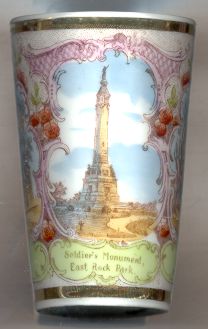
The  Soldiers' and Sailors' Monument [left] is located high on a promontory at the summit of East Rock Park.
It was designed by John M. Moffit, the sculptor was Alexander Doyle. The monument was dedicated on June 17, 1887.
A large square granite pedestal supports a tall round tapered shaft with bronze figures and plaques at base and figure at top.
The total height of the monument is 100 ft (33.5 m). It is dedicated to New Haven men who served in four wars:
the Revolutionary War (1775–1783), the War of 1812 with Great Britain, the Mexican War (1846–1848), and the Civil War (1861–1865).
Soldiers' and Sailors' Monument [left] is located high on a promontory at the summit of East Rock Park.
It was designed by John M. Moffit, the sculptor was Alexander Doyle. The monument was dedicated on June 17, 1887.
A large square granite pedestal supports a tall round tapered shaft with bronze figures and plaques at base and figure at top.
The total height of the monument is 100 ft (33.5 m). It is dedicated to New Haven men who served in four wars:
the Revolutionary War (1775–1783), the War of 1812 with Great Britain, the Mexican War (1846–1848), and the Civil War (1861–1865).

 Center Church (the Congregational United Church of Christ) [right] on Central Green
was founded in the same year as New Haven itself, in 1638. The church was completed in 1639. For more than 100 years it was the only church of New Haven.
The present church was built in 1812–1814. Asher Benjamin drew the initial plans for Center Church,
but it was Benjamin’s former student, Ithiel Town, who prepared the final design and supervised the construction.
The exterior of Center Church has remained unchanged until today and it ranks as one of the country’s most imposing Federal-style edifices.
Center Church (the Congregational United Church of Christ) [right] on Central Green
was founded in the same year as New Haven itself, in 1638. The church was completed in 1639. For more than 100 years it was the only church of New Haven.
The present church was built in 1812–1814. Asher Benjamin drew the initial plans for Center Church,
but it was Benjamin’s former student, Ithiel Town, who prepared the final design and supervised the construction.
The exterior of Center Church has remained unchanged until today and it ranks as one of the country’s most imposing Federal-style edifices.
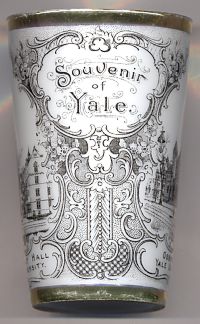
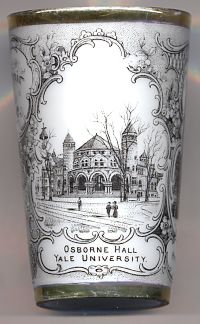
The first picture on tumbler no.B050 [right] shows a view of Osborne Hall, which has already been described above.
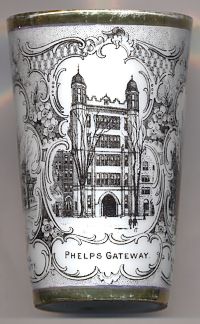
 Phelps Gateway [left] cuts under Phelps Hall and marks
the entrance to the Old Campus on College Street at the head of New Haven Green. The building in Gothic revival style
was completed in 1896 and is named for the writer and critic William Lyon Phelps (1865–1943).
Phelps Gateway [left] cuts under Phelps Hall and marks
the entrance to the Old Campus on College Street at the head of New Haven Green. The building in Gothic revival style
was completed in 1896 and is named for the writer and critic William Lyon Phelps (1865–1943).
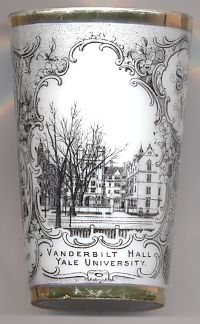
 Vanderbilt Hall [left],
built in 1894, was donated by Cornelius Vanderbilt II
and his wife in memory of their son, William Henry II, a junior at Yale University, who had died in 1892.
Vanderbilt Hall [left],
built in 1894, was donated by Cornelius Vanderbilt II
and his wife in memory of their son, William Henry II, a junior at Yale University, who had died in 1892.
![[scale]](lineal.jpg)